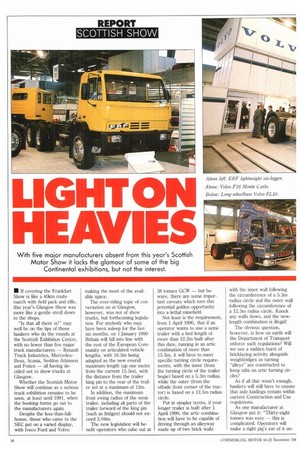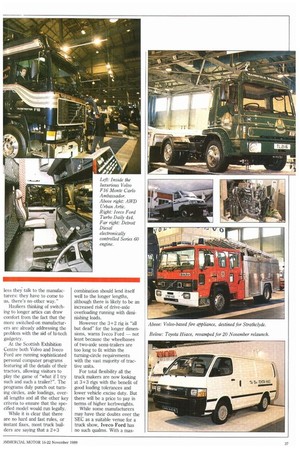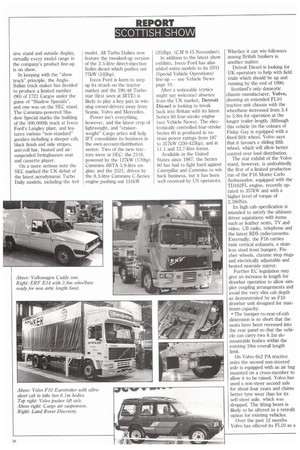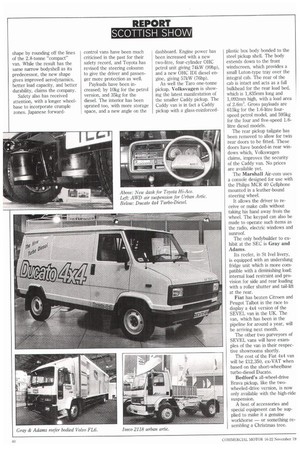LiGHT ON
Page 38

Page 39

Page 40

Page 41

Page 42

If you've noticed an error in this article please click here to report it so we can fix it.
HEAVIES
With five major manufacturers absent from this year's Scottish Motor Show it lacks the glamour of some of the big Continental exhibitions, but not the interest.
• If covering the Frankfurt Show is lace a 40Iun route march with field pack and rifle, this year's Glasgow Show was more like a gentle stroll down to the shops.
"Is that all there is?" may well be on the lips of those hauliers who do the rounds at the Scottish Exhibition Centre, with no fewer than five major truck manufacturers — Renault Truck Industries, MercedesBenz, Scania, Seddon Atkinson and Foden — all having decided not to show trucks at Glasgow.
Whether the Scottish Motor Show will continue as a serious truck exhibition remains to be seen, at least until 1991, when the booking forms go out to the manufacturers again.
Despite the less-than-fullhouse, those who came to the SEC put on a varied display, with Iveco Ford and Volvo making the most of the available space.
The over-riding topic of conversation on at Glasgow, however, was not of show trucks, but forthcoming legislation. For anybody who may have been asleep for the last six months, on 1 January 1990 Britain will fall into line with the rest of the European Community on articulated vehicle lengths, with 16.5m being adopted as the new overall maximum length (up one metre from the current 15.5m), with the distance from the trailer king pin to the rear of the trailer set at a maximum of 12m.
In addition, the maximum front swing radius of the semitrailer, including all parts of the trailer forward of the king pin (such as fridges) should not exceed 2.04m.
The new legislation will benefit operators who cube out at 38 tonnes GCW — but beware, there are some important caveats which turn this potential golden opportunity into a lethal minefield.
Not least is the requirement, from 1 April 1990, that if an operator wants to use a semitrailer with a bed length of more than 12.2m built after this date, running in an artic combination of more than 15.5m, it will have to meet specific turning circle requirements, with the inner (from the turning circle of the trailer bogie) based on a 5.3m radius, while the outer (from the offside front corner of the tractor) is based on a 12.5m radius circle.
Put in simpler terms, if your longer trailer is built after 1 April 1990, the artic combination will have to be capable of driving through an alleyway made up of two brick walls with the inner wall following the circumference of a 5.3m radius circle and the outer wall following the circumference of a 12.5m radius circle. Knock any walls down, and the newlength combination is illegal!
The obvious question, however, is how on earth will the Department of Transport enforce such regulations? Will we see a sudden burst of bricklaying activity alongside weighbridges as turning "alleys" are constructed to keep tabs on artic turning circles?
As if all that wasn't enough, hauliers will still have to ensure that axle loadings remain within current Construction and Use regulations.
As one manufacturer at Glasgow put it: "Thirty-eight tonnes was easy — this is complicated. Operators will make a right pig's ear of it un less they talk to the manufacturers: they have to come to us, there's no other way."
Hauliers thinking of switching to longer artics can draw comfort from the fact that the more switched-on manufacturers are already addressing the problem with the aid of hi-tech gadgetry.
At the Scottish Exhibition Centre both Volvo and Iveco Ford are running sophisticated personal computer programs featuring all the details of their tractors, allowing visitors to play the game of "what if I try such and such a trailer?". The programs duly punch out turning circles, axle loadings, overall lengths and all the other key criteria to ensure that the specified model would run legally.
While it is clear that there are no hard and fast rules, or instant fixes, most truck builders are saying that a 2+3 combination should lend itself well to the longer lengths, although there is likely to be an increased risk of drive-axle overloading running with diminishing loads.
However the 3+2 rig is "all but dead" for the longer dimensions, warns Iveco Ford — not least because the wheelbases of two-axle semi-trailers are too long to fit within the turning-circle requirements with the vast majority of tractive units.
For total flexibility all the truck makers are now looking at 3+3 rigs with the benefit of good loading tolerances and lower vehicle excise duty. But there will be a price to pay in terms of higher kerbweights.
While some manufacturers may have their doubts over the SEC as a suitable venue for a truck show, Iveco Ford has no such qualms. With a mas
sive stand and outside display, virtually every model range in the company's product line-up is on show.
In keeping with the "show truck" principle, the AngloItalian truck maker has decided to produce a limited number (90) of 1721 Cargos under the guise of "Shadow Specials", and one was on the SEC stand. The Cummins-powered Shadow Special marks the building of the 500,000th truck at Iveco Ford's Langley plant, and features various "non-standard" goodies including a sleeper cab, black finish and side stripes, anti-roll bar, heated and airsuspended Isringhausen seat and cassette player.
On a more serious note the SEC marked the UK debut of the latest aerodynamic Turbo Daily models, including the 4x4 model. All Turbo Dailies now feature the tweaked-up version of the 2.5-litre direct-injection Sofim diesel which pushes out 77kW (103hp).
Iveco Ford is keen to step up its attack on the tractor market and the 190.48 Turbostar (first seen at IRTE) is likely to play a key part in winning owner-drivers away from Scania, Volvo and Mercedes.
Power isn't everything, however, and the latest crop of lightweight, and "cruiserweight" Cargo artics will help Tyr consolidate its business in the own-account/distribution sector. Two of the new tractors were at SEC: the 2118, powered by the 127kW (170hp) Cummins 6B1'A 5.9-litre engine; and the 2521, driven by the 8.3-litre Cummins C-Series engine pushing out 151kW (202hP). (CM 9-15 November).
In addition to the latest show exhibits, Iveco Ford has also added extra models to its SVO (Special Vehicle Operations) line-up — see Vehicle News page 10.
After a noticeable (cynics might say welcome) absence from the UK market, Detroit Diesel is looking to break back into Britain with its latest Series 60 four-stroke engine (see Vehicle News). The electronically controlled four-stroke Series 60 is produced in various power ratings from 187 to 317kW (250-425hp), and in 11.1 and 12.7-litre forms.
Available in the United States since 1987, the Series 60 has had to fight hard against Caterpillar and Cummins to win back business, but it has been well received by US operators. Whether it can win followers among British hauliers is another matter.
Detroit Diesel is looking for UK operators to help with field trials which should be up and running by the end of 1990.
Scotland's only domestic chassis manufacturer, Volvo, showing an extended FL10 tractive unit chassis with the wheelbase increased from 3.4 to 3.8m for operation at the longer trailer length. Although this vehicle (in the colours of Finlay Guy is equipped with a fixed fifth wheel, Volvo says that it favours a sliding fifth wheel, which will allow better control over load distribution.
The star exhibit of the Volvo stand, however, is undoubtedly the first of a limited production run of the F16 Monte Carlo Ambassador, equipped with the TD162FL engine, recently uprated to 357kW and with a higher level of torque of 2,160Nm.
Its high cab specification is intended to satisfy the ultimate driver aspirations with items such as leather seats, TV and video, CB radio, telephone and the latest RDS radio/cassette. Externally, the F16 carries twin vertical exhausts, a stainless steel front bumper, Fischer wheels, chrome step rings and electrically adjustable and heated nearside mirror.
Further EC legislation may give an increase in length for drawbar operation to allow simpler coupling arrangements and avoid the very slim cab depth as demonstrated by an F10 drawbar unit designed for maximum capacity.
The bumper-to-rear-of-cab dimension is so short that the seats have been recessed into the rear panel so that the vehicle can carry two 8.1m demountable bodies within the existing 18m overall length limit.
On Volvo 6x2 PA tractive units the second non-steered axle is equipped with an air bag mounted on a cross-member to allow it to be raised. Volvo has used a non-steer second axle for about four years and claims better tyre wear than for its self-steer axle, which was dropped. The lifting beam is likely to be offered as a retrofit option for existing vehicles.
Over the past 12 months Volvo has offered its FL10 as a lightweight 6x9 tractive unit equipped with B-ride tandemdrive bogie. The show model is fitted with Alcoa wheels, the 1'D102F power unit and the optional SR1400 14-speed synchromesh gearbox.
Since Volvo entered the fireappliance market two years ago it has received orders for over 250 vehicles, and has supplied units to over half of the 65 fire authorities in the UK.
The FL617 water tender, destined for Strathclyde, is fitted with an all-steel, Swedishbuilt, Autokaross six-man crew-cab built to meet Swedish crash standards using the standard FL6 day cab shell and doors. Bodywork was supplied by Futton and Wylie, and equipment includes an 1,820litre tank, ZF PTO and Godiva pump gear. The basic FL617 chassis remaines standard except for larger air compressor, alternator and batteries.
Having ascertained that Steyr's new masters, MAN, will actually supply the steel cab for its six-wheeler, ERF decided to debut the ES8 rigid/ tipper at the Scottish Show. The vehicle should appeal particularly to Scottish operators, who seem to like the favourable power-to-weight ratio offered by six-leggers.
The new model has the same driveline as the E8 rigid: a Cummins 6CTAA.265 197kW (264hp) engine, Eaton 6109 nine-speed gearbox, and Rockwell double-drive axles. The smaller steel cab is lighter than ERF's usual GRP cab, and the 4.3-metre-wheelbase ES8 chassis-cab has a kerbweight of 6,365kg.
Like most other manufacturers, ERF is busy revamping chassis lengths to cope with the forthcoming 16.5m overall artic lengths. From midDecember, all ERF tractors will be available with a 3.8mwheelbase. In practice this means that only the 4x2 tractor will have to be changed in specification, as the six-wheeler tractors already have a 3.8m option.
AWD's TL range now includes two urban artic tractors for operation at 18 and 21 tonnes. Designated TL18-16 and TL21-16 both use the 6.1601' Perkins Phaser turbo-diesel engine, rated at 119kW (160hp) at 2,600rpm, driving through an Eaton 4106 six-speed overdrive transmission.
Air suspension, using Dunlop rolling lobe air bags, is standard on the drive axle, but steel suspension, saving about 160kg, will be offered as an option.
The self-levelling suspension incorporates an air-dump capability for easy coupling. Its low load height, some 250min lower than the TL 17-tonner, is achieved by the combination of the air suspension system, the use of low-profile 245/70x19.5 tyres and a 214mm shallowsection frame.
Trailer/payload capacities, given as 14.5 and 17.5 tonnes, are expected to prove popular with distribution operations. A more powerful 134kW (180hp) version is planned for sometime in the new year. Leyland Des three exhibits at 7.5 tonnes and above include the most powerful Roadrunner model. The 7.5tonne 8.15 is powered by the 5.88-litre Cummins B-Series engine, producing 108kW (145hp), which is matched to a five-speed, Turner 15-290, synchromesh gearbox. The cab's QX package improves comfort and styling with an air suspension seat, full carpeting and a radio/cassette.
At 17 tonnes the 17.18 Freighter is specified with the 6.2-litre Daf engine which, in turbocharged form, produces 134kW (180hp).
Leyland Dafs most powerful tractive unit, the FlsG 95.380, is being shown in 6x2 twinsteer form equipped with a space cab which has airsuspended seats an electrically operated window, tinted glass and an electrically-controlled roof hatch as standard.
The 11.6-litre turbocharged and charge-cooled Daf engine is rated at 286kW (383hp) and develops 1,525Nm (1125ibft) of torque.
Toyota's popular Hiace panel van has been revamped for the show, and goes on sale on 20 November. The company holds eighth place in the 1.8-3.5-tonne sector, with 2% of the total market to September this year, and these mediocre sales have been blamed on the distinctly Japanese shape of the Hiace, together with its narrow bodyshell. The new petrol version will cost 28,745 ex-VAT; the diesel, 29,745 ex-VAT.
Toyota has tried to give the new Hiace a more European shape by rounding off the lines of the 2.8-tonne "compact" van. While the result has the same narrow bodyshell as its predecessor, the new shape gives improved aerodynamics, better load capacity, and better durability, claims the company.
Safety also has received attention, with a longer wheelbase to incorporate crumple zones. Japanese forward
control vans have been much criticised in the past for their safety record, and Toyota has revised the steering coloumn to give the driver and passenger more protection as well.
Payloads have been increased; by 10kg for the petrol version, and 35kg for the diesel. The interior has been uprated too, with more storage space, and a new angle on the dashboard. Engine power has been increased with a new two-litre, four-cylinder OHC petrol unit giving 74kW (99hp), and a new OHC IDI diesel engine, giving 57kW (76hp).
As well the Taro one-tonne pickup, Volksvagen is showing the latest manifestation of the smaller Caddy pickup. The Caddy van is in fact a Caddy pickup with a glass-reinforced plastic box body bonded to the steel pickup shell. The body extends down to the front windscreen, which provides a small Luton-type tray over the integral cab. The rear of the cab is intact and acts as a full bulkhead for the rear load bed, which is 1,835mm long and 1,092mm high, with a load area of 2.6m3. Gross payloads are 615kg for the 1.6-litre fourspeed petrol model, and 595kg for the four and five-speed 1.6litre diesel models.
The rear pickup tailgate has been removed to allow for twin rear doors to be fitted. These doors have bonded-in rear windows which, Volkswagen claims, improves the security of the Caddy van. No prices are available yet.
The Marshall Air-corn uses a console designed for use with the Philips MCR 40 Cellphone mounted in a leather-bound steering wheel.
It allows the driver to receive or make calls without taking his hand away from the wheel. The keypad can also be made to operate such items as the radio, electric windows and sunroof.
The only bodybuilder to exhibit at the SEC is Gray and Adams.
Its reefer, in St lvel livery, is equipped with an underslung fridge unit which is more compatible with a diminishing load; internal load restraint and provision for side and rear loading with a roller shutter and tail-lift at the rear.
Fiat has beaten Citroen and Peugot Talbot in the race to display a 4x4 version of the SEVEL van in the UK. The van, which has been in the pipeline for around a year, will be arriving next month.
The other two purveyors of SEVEL vans will have examples of the van in their respective showrooms shortly.
The cost of the Fiat 4x4 van will be 212,350, ex-VAT when based on the short-wheelbase turbo-diesel Ducato.
Bedford's all-wheel-drive Brava pickup, like the twowheeled-drive version, is now only available with the high-ride suspension.
A host of accessories and special equipment can be supplied to make it a genuine workhorse — or something resembling a Christmas tree.


























































































































